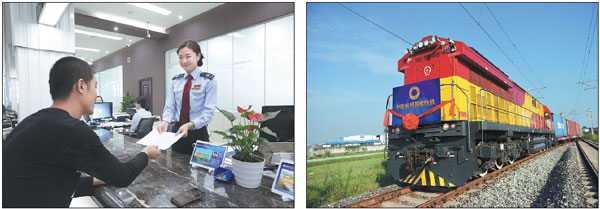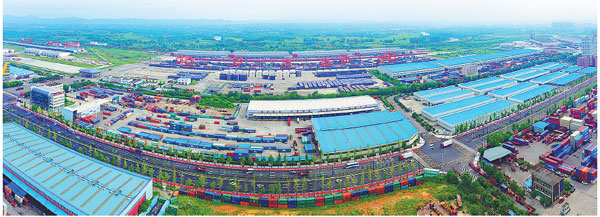Chengdu Qingbaijiang Railway Port Area of the China Pilot Free Trade Zone in Sichuan, a start point for the China Railway Express in Chengdu, is set to be a hub for a combined rail and sea transport route under the framework of the Belt and Road Initiative.
Local officials said that a port, designed for grain imports in Qingbaijiang Railway Port Area, will be completed soon, though they did not specify a date. Grain from Russia and Kazakhstan, among other nearby countries will be sold in Chengdu, the capital city of Southwest China's Sichuan province, and other inland cities in China, through the new port. With the new port, the area's annual processing capacity for the importation of grain will increase to 300,000 metric tons. The new port will also be capable of storing 4,330 tons of grain.
The area, established in 2017, has undergone continuous upgrades to meet business demand. Officials hope to step up efforts to facilitate customs clearance and build the area into an international trade port.
The area has developed one of the largest railway containers handling centers in Asia, a domestic leading container logistics service park and a bulk goods logistics park. Officials plan to build an unmanned container processing center similar to those in Shanghai and Shandong's Qingdao. The region aims to build a railway-centered unmanned port capable of handling 4 million twenty-foot equivalent units, or TEUs, of containers annually.
Chengdu railway bonded logistics center (Type B) is also under construction in the area. In China, a Type B bonded logistics center is a centralized customs-supervised area operated by a domestic enterprise's legal representative in China. That representative specializes in the bonded warehousing logistics business.
Logistics hub
Qingbaijiang Railway Port Area has long been committed to enhancing local efficiency. The increasing operation capacity of international railway services has allowed the area to expand its service network to more cities across the world.
To date, the China Railway Express (Chengdu) route, also known as the China-Europe freight train, has 25 stops in foreign countries. It connects Chengdu with 14 domestic cities. Seven international railway transport channels and five combined sea-rail channels have been developed.
According to the area's authority, the China Railway Express in Chengdu has become an iconic railway service in China, covering the largest number of countries, while also being the most stable in terms of frequency of operation and most helpful to relevant industries.
Since its opening, the railway service route has played an important role in connecting Sichuan province with other parts of the world. Through this line, goods produced in Sichuan and other regions in China can be exported to other countries while products from Europe can enter China more conveniently, according to local officials.
The railway port management authority in the area has established a partnership with logistics parks in Belarus, Poland and Spain in recent years.
It's also planning to build a cooperation promotion platform which combines trade, culture, technology and education under one roof.
In 2018, a total of 2,619 international freight trains left from Chengdu to other parts of the world. The China Railway Express in Chengdu contributed to 1,591 of those journeys.
Promoting reforms
As part of the China Pilot Free Trade Zone in Sichuan, Qingbaijiang Railway Port Area pledged to carry out reform assignments over the past two years. A total of 54 reform results have been unveiled.
Chengdu International Inland Port Operations, based in the railway port, issued its first combined bill of lading in April 2017 to offer more convenience to businesses. The new model, which allows companies to use railway service documents to raise finance, is expected to be introduced around China.
Chengdu Rongmao Lanchi Parallel Import Automobile Trade is a beneficiary of the innovative model.
According to Zheng Chenghuan, a board member of Rongmao Lanchi, more than 100 million yuan ($14.91 million) had to be paid in advance to import 100 high-end cars without a combined bill of lading. The pre-payment can be lowered to about 20 million yuan by using a combined bill of lading.
"The combined bill of lading not only helps us reduce financial pressure, but can also protect us from the risks of foreign trade," Zheng said.
The area is also the first to allow completed vehicles to be imported through the sea-rail combined model. Compared with the traditional sea-road model, which needs customs clearance at cities with seaports and uses road networks to deliver automobiles to inland cities, the costs are largely the same. However, the customs clearance time can be shortened by nearly 20 percent.
Qingbaijiang Railway Port Area has been working hard to optimize its business environment and enhance its government service quality.
It will speed up ports construction, develop more international railway freight services, upgrade infrastructure, modern industries and expand the talent pool to further enhance its business environment.

Left: A staff member serves a resident in the government service center of Chengdu Qingbaijiang Railway Port Area. Bai Guibin / For China Daily Right: The China Railway Express (Chengdu) greatly expands Chengdu’s trade network. Zhang Lang / For China Daily

A bird's-eye view of Chengdu International Railway Port in Qingbaijiang Railway Port Area. Bai Guibin / For China Daily
Copyright ©1997- by CRI Online All rights reserved